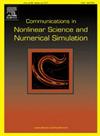流动流体热超弹性圆柱壳非线性振动的不同参数分析
IF 3.4
2区 数学
Q1 MATHEMATICS, APPLIED
Communications in Nonlinear Science and Numerical Simulation
Pub Date : 2025-04-21
DOI:10.1016/j.cnsns.2025.108886
引用次数: 0
摘要
由橡胶材料组成的超弹性壳体结构能够在很宽的温度范围内工作,从而产生丰富的振动行为。因此,考虑到几何非线性和材料非线性,首次研究了含流动流体的热超弹性圆柱壳(THCSs-FF)非线性振动响应的一些不同参数分析。利用壳体理论、热超弹性模型、速度势能和能量变分法建立了 THCSs-FF 的动力学模型。为了获得频率和振幅关系,应用谐波平衡法(HBM)求解了 THCS-FF 的运动方程。对固有频率、振幅和混沌振动进行了参数分析。模拟结果表明,温差增大和流体速度减小会提高 THCS-FF 的固有频率。在不同的参数值下,THCS-FF 具有硬化行为。然而,温度的变化对 THCS-FF 的振幅影响很小。结构参数的增加导致一阶和二阶硬化行为呈现出不同的趋势。研究人员对带流体的热超弹性壳体和流动流体进行了对比研究,结果进一步表明流动流体加速了热超弹性圆柱形壳体的混沌响应过程。本文章由计算机程序翻译,如有差异,请以英文原文为准。
Different parameter analysis on nonlinear vibrations for thermo-hyperelastic cylindrical shells with flowing-fluid
The hyperelastic shell structures composed of rubber materials have the ability to work in a wide range of temperatures, resulting in abundant vibration behaviors. Therefore, considering both geometric and material nonlinearities, some different parameter analysis on the nonlinear vibration responses of the thermo-hyperelastic cylindrical shells containing flowing-fluid (THCSs-FF) are investigated for the first time. The shell theory, thermo-hyperelastic model, velocity potential and energy variational method are used to establish the dynamic model of the THCSs-FF. To obtain the frequency and vibration amplitude relations, the harmonic balance method (HBM) is applied to solve the obtained motion equations for the THCSs-FF. Some parameter analysis on the natural frequencies, vibration amplitudes and chaotic vibrations are conducted. The simulation results indicate that the increasing temperature difference and decreasing fluid velocity enhance the natural frequencies of the THCSs-FF. The THCSs-FF perform the hardening behaviors under different parameter values. However, the changes of temperature show slight effects on the vibration amplitudes of the THCS-FF. The increase of structural parameters causes the hardening behaviors of the first-and second-order to present different trends. A comparative investigation between the thermo-hyperelastic shells with the fluid and flowing-fluid is conducted, and the result further indicates that the flowing-fluid accelerates the process of chaotic responses for the thermo-hyperelastic cylindrical shells.
求助全文
通过发布文献求助,成功后即可免费获取论文全文。
去求助
来源期刊

Communications in Nonlinear Science and Numerical Simulation
MATHEMATICS, APPLIED-MATHEMATICS, INTERDISCIPLINARY APPLICATIONS
CiteScore
6.80
自引率
7.70%
发文量
378
审稿时长
78 days
期刊介绍:
The journal publishes original research findings on experimental observation, mathematical modeling, theoretical analysis and numerical simulation, for more accurate description, better prediction or novel application, of nonlinear phenomena in science and engineering. It offers a venue for researchers to make rapid exchange of ideas and techniques in nonlinear science and complexity.
The submission of manuscripts with cross-disciplinary approaches in nonlinear science and complexity is particularly encouraged.
Topics of interest:
Nonlinear differential or delay equations, Lie group analysis and asymptotic methods, Discontinuous systems, Fractals, Fractional calculus and dynamics, Nonlinear effects in quantum mechanics, Nonlinear stochastic processes, Experimental nonlinear science, Time-series and signal analysis, Computational methods and simulations in nonlinear science and engineering, Control of dynamical systems, Synchronization, Lyapunov analysis, High-dimensional chaos and turbulence, Chaos in Hamiltonian systems, Integrable systems and solitons, Collective behavior in many-body systems, Biological physics and networks, Nonlinear mechanical systems, Complex systems and complexity.
No length limitation for contributions is set, but only concisely written manuscripts are published. Brief papers are published on the basis of Rapid Communications. Discussions of previously published papers are welcome.
 求助内容:
求助内容: 应助结果提醒方式:
应助结果提醒方式:


